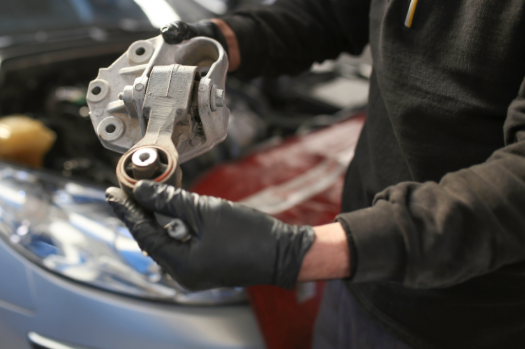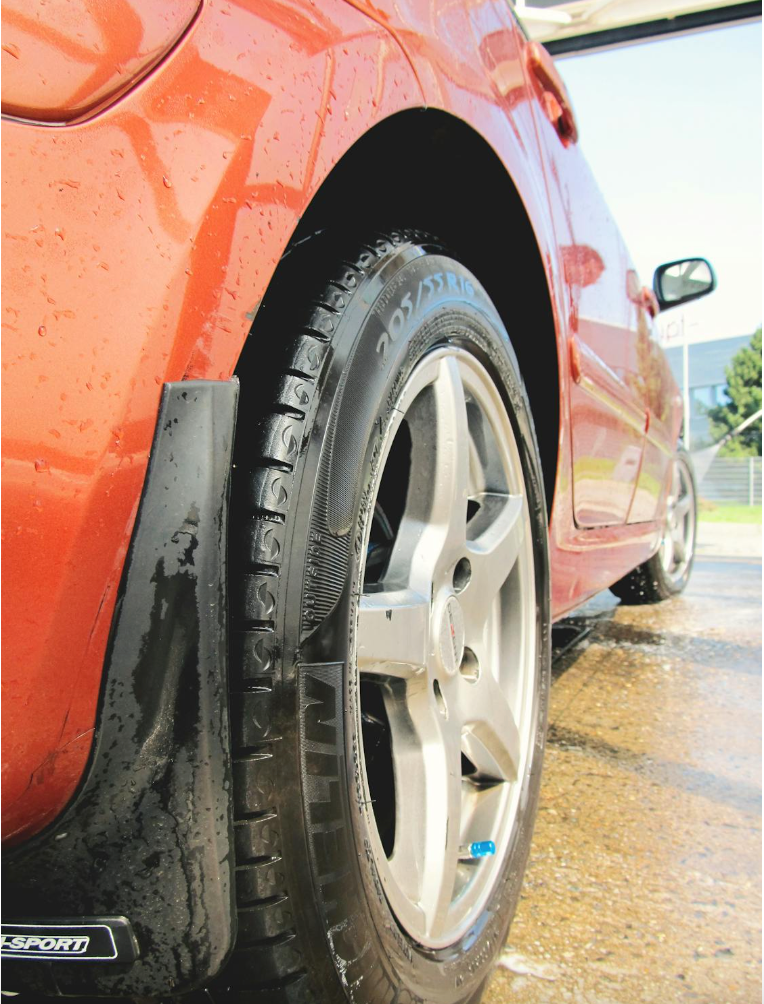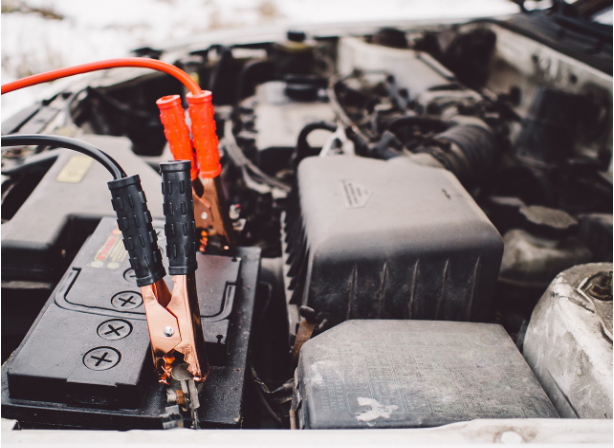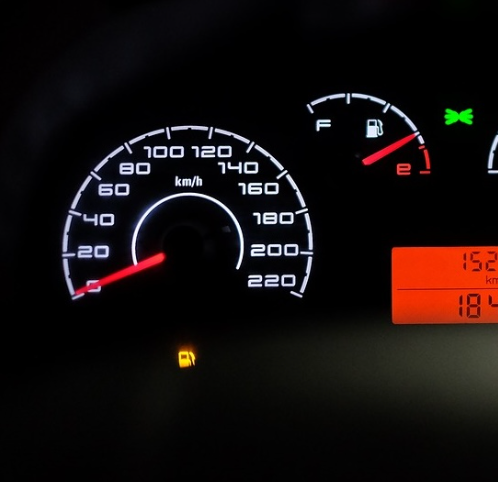NOW HIRING! Visit our Careers page to apply today.
2025 Guide to Engine Mount Maintenance: Preventing Unnecessary Wear and Tear
Michael Kenyon • January 28, 2025
Keeping Your Ride Smooth, Stable, and Stress-Free

Keeping Your Ride Smooth, Stable, and Stress-Free
Your car's engine is an engineering masterpiece, with a symphony of moving parts working together to drive you down the road. But have you ever considered what keeps that powerful machine firmly in place? Engine mounts—often overlooked but crucial components—ensure your engine stays stable and vibrations remain minimal. When functioning properly, they’re practically invisible; however, as they begin to wear out, their absence becomes all too noticeable.
Let's delve into the realm of engine mounts, explore their significance, and discover how proactive maintenance can prevent costly repairs and ensure a smooth ride.
What Are Engine Mounts and What Do They Do?
Engine mounts are the parts responsible for attaching your car's engine to its chassis. Typically constructed from rubber and metal, these compact yet robust components serve two key purposes: the rubber functions as a cushion to dampen vibrations and noise, while the metal offers strength and durability. This combination ensures that your engine remains securely in place during driving, regardless of how uneven or bumpy the road may be.
Engine mounts play a crucial role that extends beyond simply providing stability. By reducing engine movement, they shield other components like the exhaust system and drivetrain from excessive stress. If the mounts are not working correctly, it can significantly impact your car's performance and comfort.
Signs Your Engine Mounts Might Need Attention
Similar to other components of your vehicle, engine mounts have a limited lifespan. They can degrade over time due to factors like wear and tear, exposure to heat, and constant vibrations.
When this occurs, you may notice:
- Enhanced vibrations or noise within the cabin
- A clunking or banging noise during acceleration or deceleration.
- Excessive engine movement or swaying when changing gears
- Engine component misalignment
These symptoms often begin subtly but can rapidly worsen if overlooked. Identifying them early can significantly impact outcomes.
Why Engine Mount Maintenance Matters
Ignoring your engine mounts can trigger a series of issues. When mounts are worn out or damaged, they lose their ability to effectively absorb vibrations, forcing other components to endure the excessive stress.
This may result in:
- Increased deterioration of belts, hoses, and other engine components
- Possible harm to the transmission or exhaust system
- Decreased fuel efficiency and performance
Consistently maintaining your engine mounts helps avoid problems and improves your driving experience. A smooth, quiet ride is not merely a luxury; it's an indicator of a well-maintained vehicle.
The Lifespan of Engine Mounts
What is the lifespan of engine mounts? The durability of engine mounts can vary based on several factors, including your driving habits, road conditions, and the specific make and model of your vehicle. Typically, they last around five to seven years. However, heavy-duty activities like towing or frequent stop-and-go traffic may reduce their longevity.
Frequent inspections are essential for identifying wear before it turns into a significant issue. While many drivers only notice problems once symptoms become severe, taking a proactive approach can prevent unexpected repairs.
How to Care for Your Engine Mounts
To care for your engine mounts, begin with good driving habits. Avoid aggressive acceleration, sudden braking, and excessive idling to minimize stress on these parts. Furthermore, maintaining a routine service schedule for your engine and transmission can help prevent unnecessary wear on the mounts.
Another important aspect is to regularly check your engine mounts. Although this task is best handled by professionals, you can monitor visible signs of wear yourself, such as cracks in the rubber or fluid leaks from hydraulic mounts.
The Role of Technology in Modern Engine Mounts
Did you know that engine mounts today are more advanced than ever before? Many modern vehicles feature hydraulic or active mounts that adapt to driving conditions. Hydraulic mounts offer superior vibration damping, while active mounts utilize electronic controls to dynamically adjust stiffness.
These innovations enhance comfort and performance, though they may also make maintenance more complex. To ensure proper care and timely replacement, it is crucial to understand the type of engine mounts in your vehicle.
Replacing Engine Mounts: What to Expect
If your engine mounts need replacement, it's not something you should delay. The process involves slightly lifting the engine and carefully removing the old mounts before installing new ones. This precise task requires specialized tools and expertise.
Although this might seem intimidating, a professional can efficiently complete the job, bringing back your vehicle's stability and performance. The cost of replacement varies based on your car's make and model; however, it's an investment that pays off in terms of your vehicle’s longevity.
Engine Mount Myths and Misconceptions
Let’s clear up a few common misconceptions about engine mounts:
Myth:
Engine mounts don’t need maintenance.
Fact:
Like any part of your car, they wear out over time and require attention.
Myth:
Replacing engine mounts isn’t urgent.
Fact:
Ignoring worn mounts can lead to serious damage and costly repairs.
Myth:
Only older cars have engine mount issues.
Fact:
Even modern vehicles with advanced mounts can experience wear and tear.
Understanding these truths can help you make informed decisions about maintenance.
Choosing the Right Engine Mounts for Your Car
When replacing engine mounts, it's crucial to select the appropriate type for your vehicle. Available options include:
OEM (Original Equipment Manufacturer) mounts: Crafted to precisely fit the specifications of your vehicle.
Aftermarket mounts:
Typically more budget-friendly, though quality may differ.
Seeking advice from a reliable technician can assist you in determining the best option for your car and budget.
The Future of Engine Mounts
As automotive technology advances, engine mounts are also evolving. Researchers are investigating innovative materials and designs to boost durability, minimize vibrations, and improve fuel efficiency. Ranging from lightweight composites to intelligent mounts that interact with your car's computer system, the future of engine mounts is as dynamic as the vehicles they support.
Why February Is the Perfect Time for Engine Mount Maintenance
February might not be the most apparent choice for engine maintenance, yet it's actually an optimal time. The colder months exert extra pressure on your vehicle, offering a prime opportunity to ensure everything is in excellent shape before spring driving season begins. Engine mounts are no exception; examining them now can help prevent problems from worsening and keep your car running smoothly throughout the year.
Final Thoughts
Engine mounts may not be the most glamorous component of your vehicle, but they are crucial to enhancing your driving experience. By learning about their function, identifying signs of wear and tear, and maintaining them proactively, you can ensure a smoother and quieter ride while preventing costly repairs. Whether you're navigating Elgin's icy streets in winter or embarking on a summer road trip, taking care of your engine mounts keeps your car prepared for any journey ahead.
Keep in mind that your vehicle is a complex system where each component plays an essential role. Pay attention to your engine mounts, and they will provide you with years of dependable performance.
Discover unparalleled auto repair services at KS Autocare in Elgin, IL. Our team of expert ASE-certified technicians is dedicated to honesty, trust, and top-notch service. Specializing in all makes and models, we're committed to providing exceptional care and attention to every vehicle. Visit us at 575 Page Ave, Elgin, IL 60120, or call 224-279-1990 to schedule your appointment. Experience the difference with KS Autocare, where integrity and quality drive us forward. For more information, visit our website.

By Michael Kenyon
•
April 14, 2025
Blooming Roads and the Right Tires for a Smoother Ride. Spring in Elgin signals new beginnings with rising temperatures, extended daylight, and the much-anticipated annual tulip bloom. However, as these vibrant flowers gently rise from the earth, local roads reveal a contrasting tale. The effects of winter remain evident through potholes, slippery surfaces, and erratic weather conditions. Just like tulips draw strength from their roots for stability, your vehicle needs suitable tires to navigate safely on spring's unpredictable roadways. The Changing Landscape of Spring Roads Spring might offer a break from the icy streets of winter, but road conditions don't improve overnight. Melting snow and rain can lead to slippery surfaces, while the freeze-thaw cycle often results in cracks and potholes. Wet roads pose challenges similar to those caused by ice, and unpredictable temperatures mean you never know if you'll encounter dry asphalt or an unexpected downpour. These changing conditions require your tires to be adaptable. Just as tulips adjust to the combination of sun and rain in spring, your tires should be equipped to handle the specific demands of this season. The Root System of Good Traction A tulip's roots secure it firmly, absorbing nutrients from the soil to promote its growth. Similarly, tires grip the road to ensure your car remains stable and responsive. However, not all tires have the appropriate "root system" for spring’s unpredictable weather conditions. Winter tires, characterized by their deep grooves and flexible rubber composition, are excellent on snow and ice but face challenges in warmer conditions. Conversely, summer tires are tailored for hot, dry roads but aren't well-suited to the wet and cool environment of early spring. All-season and dedicated spring tires fill this gap effectively by offering a balanced combination of grip and adaptability for these varied conditions. Tread Patterns: The Petals of Performance Just as the shape and function of tulip petals are determined by their structure, a tire's tread pattern plays a crucial role in how it navigates various road conditions. Certain designs guide water away to minimize hydroplaning risk, while others enhance road contact for improved traction. Directional tread patterns, characterized by their "V" shape design, excel in wet conditions by efficiently channeling water away from under the tire. Asymmetric tread patterns incorporate various grip zones to provide stability on both dry and wet surfaces. Grasping these designs can guide you in selecting a tire that performs like a firmly planted tulip, resilient against the unpredictable challenges of spring weather. Air Pressure: Keeping Your Tires in Full Bloom Tulips require an optimal balance of water and sunlight to bloom, just as tires need the proper air pressure for peak performance. In cold winter months, air contracts leading to underinflated tires; conversely, warmer spring temperatures can cause overinflation. Both conditions negatively impact traction and tread wear. Frequently monitoring your tire pressure promotes even wear and enhances performance. This simple habit has a significant impact, akin to caring for a garden— proper maintenance results in longevity and improved health. When to Swap Out Winter Tires As winter gradually comes to an end, it might be tempting to keep your winter tires on for a bit longer, particularly when chilly mornings persist. However, using winter tires on warm pavement causes them to wear down more quickly, diminishing their effectiveness and shortening their lifespan. Spring is the perfect season to switch to all-season or dedicated warm-weather tires, akin to tulips emerging from their dormancy to bask in the sunlight. Delaying this change can cause unnecessary wear and tear on your tires, decrease fuel efficiency, and result in a less responsive driving experience. Rain, Potholes, and Other Springtime Hazards Spring showers might encourage flowers to bloom, but they also increase the risk of hydroplaning. Tires with worn tread struggle to effectively channel water away, which can result in a loss of control on wet roads. By regularly checking your tire tread depth and replacing tires as necessary, you ensure that your vehicle is prepared for any April storms that come its way. Potholes present a significant issue as well. After enduring winter's freeze-thaw cycles, these roads now feature deep cracks and craters capable of harming tires, alignment , and suspension systems. Opting for durable tires with reinforced sidewalls can mitigate some impact effects, thereby lowering the chances of blowouts or rim damage. The Right Tires for Every Type of Driver Drivers have varied requirements when selecting spring tires. A commute r who travels daily on highways might find all-season touring tires ideal due to their smooth, quiet ride and long tread life. On the other hand, individuals who love weekend road trips may opt for performance tires that offer superior grip and handling across different conditions. Comprehending your driving habits and routes is essential for selecting the most suitable tires for upcoming seasons. Just as various tulip species flourish in specific climates, picking the appropriate tires guarantees a steady and dependable ride throughout spring and beyond. Keeping Your Car Grounded This Spring Just as tulips announce the arrival of spring, having the right tires equips your car for seasonal changes. Whether dealing with wet roads, potholes, or fluctuating temperatures, choosing the appropriate set of tires significantly impacts your vehicle's performance and handling. Spring is a season of renewal, and that extends to your car's relationship with the road. By checking tread depth, monitoring air pressure, and replacing winter tires at the appropriate time, you ensure your vehicle navigates smoothly through all of spring’s fluctuations. With proper preparation, your car will be as primed for spring as tulips in peak bloom. Discover unparalleled auto repair services at KS Autocare in Elgin, IL. Our team of expert ASE-certified technicians is dedicated to honesty, trust, and top-notch service. Specializing in all makes and models, we're committed to providing exceptional care and attention to every vehicle. Visit us at 575 Page Ave, Elgin, IL 60120, or call 224-279-1990 to schedule your appointment . Experience the difference with KS Autocare, where integrity and quality drive us forward. For more information, visit our website .

By Michael Kenyon
•
August 19, 2024
Choosing and Sustaining Your Tires in the Hot Summer Months! In Elgin, IL, summers present unique trials for car owners. Smooth and risk-free travel are paramount to tire upkeep and performance. The heated environment may severely affect their sturdiness and functionality. Hence, it is vital to have a firm grasp of fitting summer tires while executing consistent maintenance throughout the spell. So, let's dive into some witty insights as we explore practical methods toward sustaining durable summertime-ready rubber! Understanding Summer Tires Equipping your car with the appropriate type of tire is crucial for maximizing performance during warmer weather. Summer or high-performance tires are designed to provide superior grip and maneuverability on hot roads due to their softer rubber composition, enabling improved cornering and braking distances. Summer tires have a shorter lifespan than all-season ones owing to their softer texture, making it imperative to examine them regularly. This is especially important before embarking on prolonged road excursions or extended driving sessions. The Impact of Heat on Tires When temperatures rise, the air within tires expands and causes an increase in tire pressure. Over-inflation can cause irregular damage, reduce grip, and raise the probability of ruptures. At the same time, under-inflation leads to higher wear rates, which may shorten your vehicle's lifespan by causing overheating. Thus, adhering to proper summer maintenance practices is vital to maintain appropriate tire pressures as a safety precaution and extend their durability. To optimize your vehicle’s performance, it is recommended that you obtain a top-notch tire gauge and measure your tire pressure every 30 days. Before measuring, ensure your tires have cooled down, as higher temperatures can cause misleadingly increased readings. Tread Carefully: Monitoring Tire Wear Driving safety depends on maintaining tire tread, especially in varying summer weather conditions. This is crucial for obtaining sufficient grip on dry and wet surfaces. Regularly checking the depth of your tires' treads helps detect potential issues beforehand, preventing significant problems that could jeopardize road safety. The penny method is an easy test for measuring tire tread depth. To perform this assessment, insert a penny into one of the grooves with Lincoln’s head facing downward and note if his entire forehead remains visible. This technique could assist in deciding whether new tires are required; however, it would be wise to utilize a tread depth gauge for more precise measurements. Rotation and Alignment: Keeping Things Straight Regularly rotating your tires and maintaining proper alignment is essential for achieving consistent tire wear and optimal performance. This involves moving each tire around the vehicle to ensure even wear across all four wheels, enhancing fuel efficiency and prolonging rim life. Ignoring this crucial habit can compromise safety on the road as well as shorten your tires' lifespan. Therefore, don't neglect these maintenance practices if you want to maximize both driving safety and longevity! Wheel alignment involves making sure that all tires are parallel to each other and perpendicular to the ground. This helps prevent uneven tire wear and improves vehicle handling. If you notice that your car is pulling in one direction or if it has hit a pothole or curb, it's recommended that you have your wheel alignment inspected.
By Rankpay Content
•
June 10, 2024
Your brakes are your primary defense against accidents whenever you hit the road. Regular brake inspections aren’t just about maintaining your vehicle—they’re about ensuring your safety and the safety of everyone around you. Brake services are an essential part of vehicle ownership. Make sure your vehicle has stopping power, and don’t neglect your brake maintenance!...
By Rankpay Content
•
May 8, 2024
Great mechanics don’t just fix cars; they are like detectives who investigate and identify the root causes of car problems with great precision. They can decipher strange engine sounds and figure out the reason behind stubborn warning lights. Their ultimate goal is to solve the mystery and get your car back on the road....
By Rankpay Content
•
April 8, 2024
Congrats on your brand-new car! You’re probably super excited to hit the road and show it off to everyone. But wait! Before you do that, let’s talk about the important stuff—your vehicle’s maintenance. Don’t worry—KS Autocare is here to help you. What you need is a go-to comprehensive guide for all things related to automotive...
By Rankpay Content
•
March 15, 2024
Did you know that finding your go-to auto repair shop and what to look for is vital to the life of your vehicle? Stepping on the gas brings freedom and adventure, but it also means caring for your four-wheeled friend. From routine checkups such as oil changes to unexpected repairs like transmission repair, having a reliable...
KS Autocare - Best Auto Repair Shop in Elgin IL
(847) 321-7834
Mon - Fri 7:00am - 6:00pm
Payment Options




KS Autocare - Best Auto Repair Shop in Elgin IL
(847) 321-7834
Mon - Fri 7:00am - 6:00pm
Services
List of Services
-
Reliable Auto Air Conditioning ServicesReliable Auto Air Conditioning Services
-
Air ConditioningAir Conditioning
-
Expert Wheel Alignment Services in Elgin, ILExpert Wheel Alignment Services in Elgin, IL
-
Expert Alternator Services in Elgin, ILExpert Alternator Services in Elgin, IL
-
Professional Automatic Transmission Services in Elgin, ILProfessional Automatic Transmission Services in Elgin, IL
-
Expert Differential and Axle Services in Elgin, ILExpert Differential and Axle Services in Elgin, IL
-
Quality Battery Service in Elgin, ILQuality Battery Service in Elgin, IL
-
Brake Repair & ServicesBrake Repair & Services
-
Brake Fluid Service | KS Autocare | Elgin, ILBrake Fluid Service | KS Autocare | Elgin, IL
-
Auto Electrical ServicesAuto Electrical Services
-
Engine Repair & ServicesEngine Repair & Services
-
Scheduled Maintenance ServicesScheduled Maintenance Services
-
Oil Change ServicesOil Change Services
-
Tire Services & AlignmentsTire Services & Alignments
-
Transmission Repair & ServicesTransmission Repair & Services
List of Services
-
Reliable Auto Air Conditioning ServicesReliable Auto Air Conditioning Services
-
Air ConditioningAir Conditioning
-
Expert Wheel Alignment Services in Elgin, ILExpert Wheel Alignment Services in Elgin, IL
-
Expert Alternator Services in Elgin, ILExpert Alternator Services in Elgin, IL
-
Professional Automatic Transmission Services in Elgin, ILProfessional Automatic Transmission Services in Elgin, IL
-
Expert Differential and Axle Services in Elgin, ILExpert Differential and Axle Services in Elgin, IL
-
Quality Battery Service in Elgin, ILQuality Battery Service in Elgin, IL
-
Brake Repair & ServicesBrake Repair & Services
-
Brake Fluid Service | KS Autocare | Elgin, ILBrake Fluid Service | KS Autocare | Elgin, IL
-
Auto Electrical ServicesAuto Electrical Services
-
Engine Repair & ServicesEngine Repair & Services
-
Scheduled Maintenance ServicesScheduled Maintenance Services
-
Oil Change ServicesOil Change Services
-
Tire Services & AlignmentsTire Services & Alignments
-
Transmission Repair & ServicesTransmission Repair & Services
Payment Options




Services
List of Services
-
Reliable Auto Air Conditioning ServicesReliable Auto Air Conditioning Services
-
Air ConditioningAir Conditioning
-
Expert Wheel Alignment Services in Elgin, ILExpert Wheel Alignment Services in Elgin, IL
-
Expert Alternator Services in Elgin, ILExpert Alternator Services in Elgin, IL
-
Professional Automatic Transmission Services in Elgin, ILProfessional Automatic Transmission Services in Elgin, IL
-
Expert Differential and Axle Services in Elgin, ILExpert Differential and Axle Services in Elgin, IL
-
Quality Battery Service in Elgin, ILQuality Battery Service in Elgin, IL
-
Brake Repair & ServicesBrake Repair & Services
-
Brake Fluid Service | KS Autocare | Elgin, ILBrake Fluid Service | KS Autocare | Elgin, IL
-
Auto Electrical ServicesAuto Electrical Services
-
Engine Repair & ServicesEngine Repair & Services
-
Scheduled Maintenance ServicesScheduled Maintenance Services
-
Oil Change ServicesOil Change Services
-
Tire Services & AlignmentsTire Services & Alignments
-
Transmission Repair & ServicesTransmission Repair & Services
List of Services
-
Reliable Auto Air Conditioning ServicesReliable Auto Air Conditioning Services
-
Air ConditioningAir Conditioning
-
Expert Wheel Alignment Services in Elgin, ILExpert Wheel Alignment Services in Elgin, IL
-
Expert Alternator Services in Elgin, ILExpert Alternator Services in Elgin, IL
-
Professional Automatic Transmission Services in Elgin, ILProfessional Automatic Transmission Services in Elgin, IL
-
Expert Differential and Axle Services in Elgin, ILExpert Differential and Axle Services in Elgin, IL
-
Quality Battery Service in Elgin, ILQuality Battery Service in Elgin, IL
-
Brake Repair & ServicesBrake Repair & Services
-
Brake Fluid Service | KS Autocare | Elgin, ILBrake Fluid Service | KS Autocare | Elgin, IL
-
Auto Electrical ServicesAuto Electrical Services
-
Engine Repair & ServicesEngine Repair & Services
-
Scheduled Maintenance ServicesScheduled Maintenance Services
-
Oil Change ServicesOil Change Services
-
Tire Services & AlignmentsTire Services & Alignments
-
Transmission Repair & ServicesTransmission Repair & Services
© 2024 KS Autocare. All Rights Reserved | Website managed by Shopgenie



